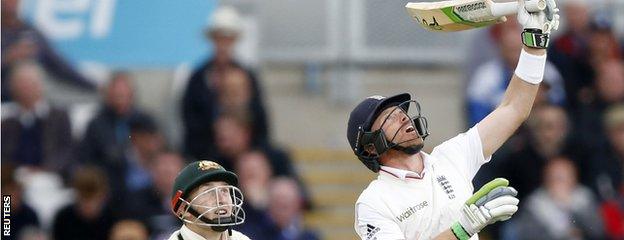Ashes 2015: Long-form cricket played in the short-form way
- Published

Stuart Broad and England's players celebrate another wicket on Thursday
A five-day contest that came within a few wickets of ending in two. Opening batsmen scoring 35-ball half-centuries, the number one ranked player in the world falling to a top-edged slog.
This is Test cricket with your finger on the fast-forward button, a battle not of attrition but acceleration, a Dickens novel abridged into a series of tweets.
Is it a good thing? The half-cut thousands pouring out of Edgbaston on Thursday evening would have given you only one answer. Who doesn't enjoy seeing an Australian team that won the last Ashes 5-0 bowled out twice in the time it takes you to fly from Sydney to London?
Except those who appreciate the charms of Test cricket are the same sort of people who find it pleasing that on the classic version of board game Snakes and Ladders there are 12 snakes and eight ladders.
It is not meant to be easy. Nothing comes without a struggle. It can speed up and slow down, but the average pace is supposed to be sedate. Defence is as important as attack. A draw that takes the best part of a week can be a very good thing indeed.
Instead we have a match that almost ended in Australia's first two-day defeat since Queen Victoria was on the throne and a trip from down under to England took longer than this entire series.
And that has been the way the Ashes of 2015 has gone. We win by a canter in 169 runs, you win in a sprint by 405. You bowl us out in 37 overs, we bowl you out in 36.4.
It is long-form cricket played in the short-form way, and in that lies the complaints of the old faithfuls.

Ian Bell was caught at the end of the first day attempting a wild shot
Never mind the excitement. Where is the quality? Where is the nuance and the subtlety? Where are the defining characteristics of a game like no other?
You can consider this as curmudgeonly as a football supporter bemoaning a 4-3 thriller instead of a 1-0 win, but this is both Test cricket's biggest strength and its greatest weakness: a long history that can act as both an anchor and a dead weight, a respect for the past that can become a distrust of the coming future.
This has been a breathless match, the shot-making as sloppy as the pace has been relentless.
When Australia collapsed on the first day for 136, they did so in a series of wild swings and hopeful slogs. In England's reply, on a pitch that is lively rather than murderous and with all the time and dry weather an English summer can offer, Ian Bell made 53 at almost a run a ball, Joe Root 63 off 75, before both fell to the sort of shot that would have brought a blush to the cheeks an old-fashioned tail-ender.
Fastest Ashes fifties | |||
|---|---|---|---|
Batsman | No of balls | Ground | Date |
D Warner (Aus) | 35 | Edgbaston | July 2015 |
G Yallop (Aus) | 35 | Old Trafford | August 1981 |
K Pietersen (Eng) | 36 | Oval | August 2013 |
When Australia batted again, David Warner's 35-ball 50 felt like only a minor change of pace. Steve Smith, fresh off a double century, statistically the finest in the world right now, top-edged a mow, unforgivable 200 runs ahead rather than 100 behind.
It took a man playing in only his second Test, Peter Nevill, to become the first man from either side to survive for more than 100 balls in an innings.
Should we complain? Maybe only the 58,000 supporters who had bought tickets for the final three days of this Test.
It has not always been pretty. It has sometimes felt like sport for the era of instant gratification and miniscule attention spans. It has borne as much resemblance to the Test cricket many were brought up on as a smartphone does to a curly-corded rotary dial landline.
And it has all been utterly memorable.
In the harum-scarum batting has been beautiful strokeplay, the off-drives of Bell and the clips through leg of Root, the innovation and aggression of Warner and the counter-attacking flays of Moeen Ali.
In the subplots have been history: Mitchell Johnson becoming only the second Australian to take both 300 Test wickets and make 2,000 Test runs; Warner scoring the joint-fastest 50 the Ashes has seen; Stuart Broad a single wicket away from being the fifth Englishman to 300 Tests scalps; Michael Clarke a captain whose ship is not just listing but who has fallen off the bridge with his lifejacket left behind.

Steven Finn's 13 overs contained five boundaries and five wickets
In the headlines is a heart-warming tale of renaissance and reinvigoration: Steven Finn, a broken man when these two sides last met, transformed from unselectable to unplayable, taking five wickets in the afternoon to push England to the brink of victory and a critical series lead this time around, getting rid of both opposition captain and key batsman in both innings having been carted for 14 in his first over of the day.
In the context of a summer this Test has conformed to expectation by turning out as precisely no-one could predict.
From an England triumph in Cardiff of a style and magnitude that on form and precedent made little sense, we have swung to a crushing Australian response in the capital, and then reverse-swung again when they had won the toss here in Birmingham to seemingly tighten their grip only to face a humiliation of their own before the weekend has even arrived.
Those old-fashioned Tests had their charm. So too did silent movies, but only the silent stars complained when their time was up.
Cricket has mutated, just as it did when Richie Benaud ripped up the captaincy rulebook in the early 1960s, just as it did when leg-spin was born again in the 1990s.
Trying to fight it is like bemoaning the fact that since your best mate had kids you barely see him any more. It is not a blip but the new reality. Today's players are not at the forefront of the T20 revolution. They are its children and its disciples.
The speed of it all? We remember great sport for its thrills and spills, not its duration. That Edgbaston Test of 2005,, external that match frequently described in the soft nostalgia of the past few weeks as the greatest of all time? It barely stretched to three-and-a-half days, and no-one could care less then or now.
Test cricket is a format supposedly in crisis. On Thursday, 316 runs were scored for the loss of 14 wickets. You couldn't take your eyes off it for an over. If that is rigor mortis, it is one hell of a death-dance.
- Published23 July 2015

- Published15 May 2018

- Published10 March 2019

- Published18 October 2019

- Published1 July 2015

- Published7 July 2015
